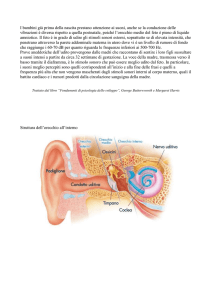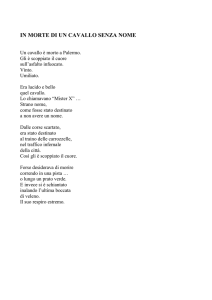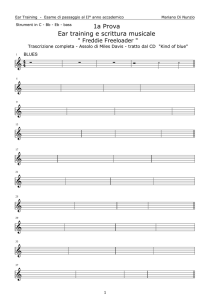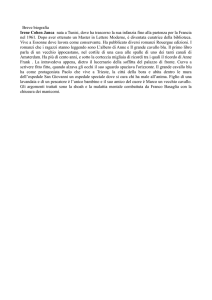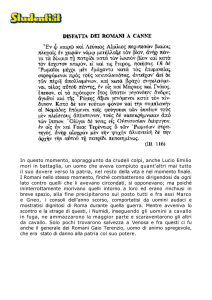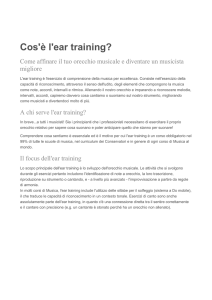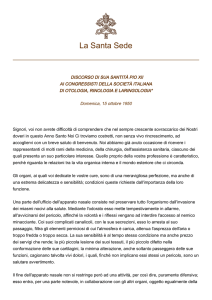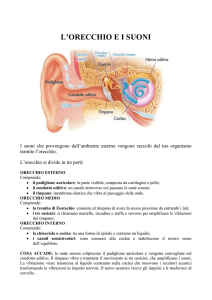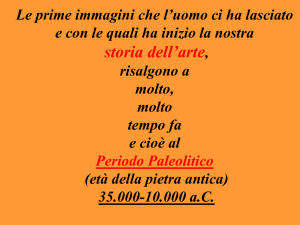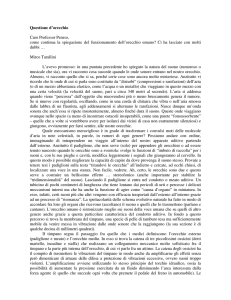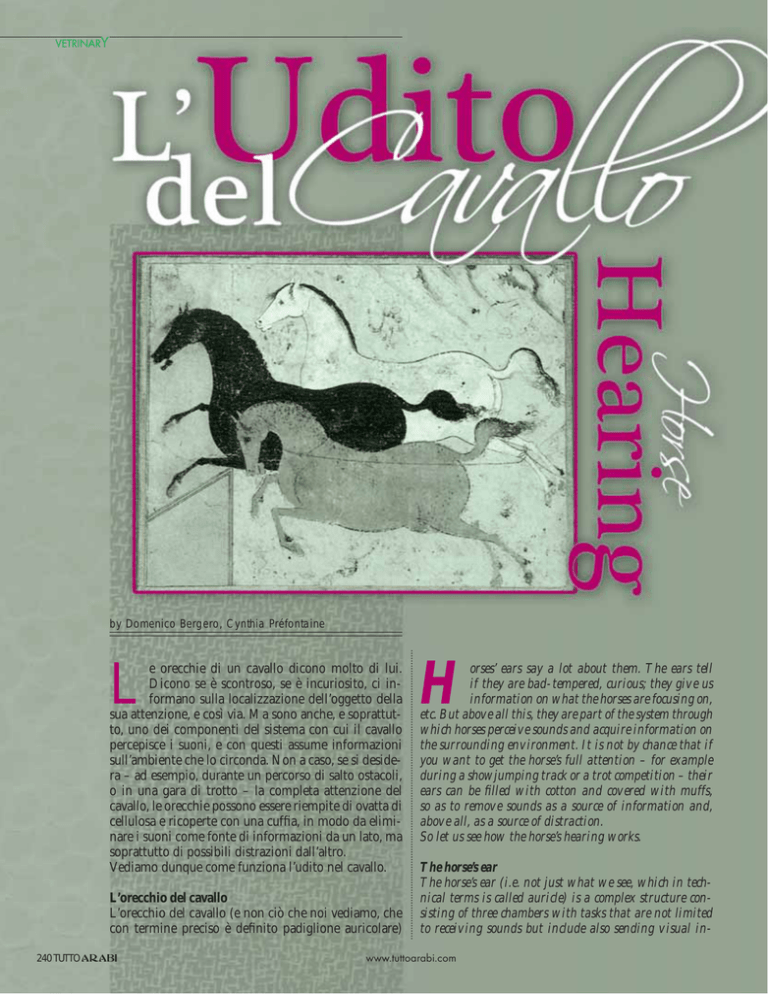
VETRINARY
by Domenico Bergero, Cynthia Préfontaine
L
H
L’orecchio del cavallo
L’orecchio del cavallo (e non ciò che noi vediamo, che
con termine preciso è definito padiglione auricolare)
The horse’s ear
The horse’s ear (i.e. not just what we see, which in technical terms is called auricle) is a complex structure consisting of three chambers with tasks that are not limited
to receiving sounds but include also sending visual in-
e orecchie di un cavallo dicono molto di lui.
Dicono se è scontroso, se è incuriosito, ci informano sulla localizzazione dell’oggetto della
sua attenzione, e così via. Ma sono anche, e soprattutto, uno dei componenti del sistema con cui il cavallo
percepisce i suoni, e con questi assume informazioni
sull’ambiente che lo circonda. Non a caso, se si desidera – ad esempio, durante un percorso di salto ostacoli,
o in una gara di trotto – la completa attenzione del
cavallo, le orecchie possono essere riempite di ovatta di
cellulosa e ricoperte con una cuffia, in modo da eliminare i suoni come fonte di informazioni da un lato, ma
soprattutto di possibili distrazioni dall’altro.
Vediamo dunque come funziona l’udito nel cavallo.
240 TUTTO ARABI
orses’ ears say a lot about them. The ears tell
if they are bad-tempered, curious; they give us
information on what the horses are focusing on,
etc. But above all this, they are part of the system through
which horses perceive sounds and acquire information on
the surrounding environment. It is not by chance that if
you want to get the horse’s full attention – for example
during a showjumping track or a trot competition – their
ears can be filled with cotton and covered with muffs,
so as to remove sounds as a source of information and,
above all, as a source of distraction.
So let us see how the horse’s hearing works.
www.tuttoarabi.com
VETERINARY
formation.
The mobility of horses’ ears is important so that they can
locate the source of the sound. Therefore, their position
can indicate the direction in which the horse is focusing.
Lowering the ears is often interpreted as a threat signal
but can also suggest a submissive attitude.
The outer ear
The outer ear consists of the auricle (so-called pinna) and
of a cartilage connecting it to the cranium. The purpose
of the funnel-like shape is to channel the sounds towards
the inner ear and the eardrum, which turns sounds into
information that can be interpreted by the nerve system.
The movement of each auricle is controlled by as many as
sixteen muscles (!), each of which can contract independently. So the horse is able to focus its hearing attention
on two points at the same time. When the ears are fully
reversed back, the auditory canal is almost fully closed,
and in this situation the horse can hear very little.
VOLUME ED INTENSITÀ DEI SUONI
Il volume è l’intensità di un suono, ed è misurato
in decibel (dB); un suono di 3 dB è quello
relativo a un sussurro, mentre un motore di un
jet emette un suono pari a 130 dB.
I cavalli riescono a distinguere meglio dell’uomo
tra rumori di simile ampiezza. Sembra infatti
che possano riconoscere differenze di un solo
decibel nel range tra 69 e 70 dB.
I cavalli possono proteggersi dai rumori troppo
intensi piegando le orecchie all’indietro e
chiudendo in questo modo il canale auricolare.
Se in presenza di un forte rumore il cavallo
abbassa le orecchie all’indietro non è dunque
sempre spaventato, ma cerca semplicemente
di proteggersi da questa fonte di disagio. Allo
stesso modo, il cavallo può piegare le orecchie
all’indietro se si urla verso di lui. In questi casi,
bisogna considerare bene il quadro generale
per comprendere se il cavallo vuole solo
proteggersi, è spaventato o sta per diventare
aggressivo.
The middle ear
The middle ear is separated from the outer ear by a membrane called eardrum or tympanic membrane. The middle ear includes three bones or ossicles (malleus or hammer,
incus or anvil, and stapes or stirrup) which amplify the
vibrations recorded by the eardrum (every sound produces vibrations, some audible and some not: in this case
we refer to them as ultrasounds. In animals the range of
audible vibrations can differ from the man’s one so they
can perceive sounds that we cannot hear) and transfer
è una struttura complessa formata da tre camere, i cui
compiti non si limitano alla ricezione di suoni ma arrivano fino all’invio di informazioni visive.
La mobilità delle orecchie di un cavallo è infatti importante nella localizzazione della fonte del suono: per
questo la loro posizione può indicare il punto in cui è
focalizzata l’attenzione in quel momento. Abbassare le
orecchie è spesso interpretato come un segnale di minaccia, ma può anche essere parte di un atteggiamento
di sottomissione.
L’orecchio esterno
L’orecchio esterno consiste nel padiglione auricolare (la
cosiddetta pinna) e in una cartilagine che lo collega al
cranio. La forma ad imbuto serve a convogliare i suoni
verso l’orecchio interno e la membrana del timpano,
quella che trasforma i suoni in informazioni interpretabili dal sistema nervoso. Il movimento di ciascun
padiglione auricolare è controllato da ben sedici muscoli(!), che possono contrarsi ciascuno indipendentemente. Il cavallo è quindi capace di concentrare la sua
attenzione uditiva su due punti contemporaneamente. Quando le orecchie sono portate completamente
all’indietro, il canale auricolare è quasi completamente
chiuso e quindi il cavallo può sentire molto poco in
questa situazione.
www.tuttoarabi.com
TUTTO ARABI 241
VETRINARY
VOLUME AND INTENSITY OF SOUNDS
Volume is the intensity of a sound and is measured in decibel (dB). A whisper
is a 3 dB sound whereas a jet engine produces a sound of 130 dB.
Horses can distinguish between sounds of similar amplitude better than men
can. It is in fact believed that they can detect differences of just 1 decibel in
the range between 69 and 70 dB.
Horses can protect themselves from too loud a noise by folding their ears
backwards, thus closing the auditory canal. If the noise is too loud and the
horses fold the ears backwards, it does not always mean that they are scared,
but they are simply trying to protect from this source of discomfort. Similarly,
horses can fold their ears backwards when we shout at them. In these cases
it is necessary to consider the whole picture in order to understand whether
the horses are simply trying protect themselves, are scared or are about to
become aggressive.
L’orecchio medio
L’orecchio medio è separato dall’esterno da una membrana detta timpano o tamburo auricolare. Contiene
tre ossicini (martello, incudine e staffa) che amplificano le vibrazioni registrate dal timpano (tutti i suoni
producono vibrazioni, alcune delle quali sono udibili,
mentre altre non lo sono: si parla in questi casi di ultrasuoni. Negli animali, la scala di vibrazioni udibili
può essere diversa da quella dell’uomo, e per questo
possono percepire rumori a noi sconosciuti) e le trasferiscono all’orecchio interno.
Un corto canale, la tuba di Eustachio, mette in comunicazione l’orecchio medio con il faringe. Questo
mantiene la pressione interna a questa struttura uguale
a quella esterna. In caso contrario, infatti, alcune onde
non vengono trasmesse correttamente alle regioni
sensitive dell’orecchio interno. Dietro la mandibola,
nel cavallo, si trova un allargamento della tuba in una
242 TUTTO ARABI
them into the inner ear.
A short channel called Eustachian tube connects the middle ear to the pharynx. This channel equalizes the internal pressure of this structure with that of the external
one. Otherwise some sound waves may not be correctly
transmitted to the sensitive areas of the inner ear. In
horses, behind the mandible or lower jaw is an expansion of the tube forming a structure called guttural pouch;
its purpose is unknown but we all know very well the
infections of these structures (inflammations), source of
many worries.
The inner ear
This part of the ear includes the cochlea, with the hearing sensory cells and the so-called vestibular apparatus,
consisting of the utricle, semi-circular canals and saccule.
The vestibular apparatus is important for the sense of
balance. Conversely, the hearing sensory cells convert,
www.tuttoarabi.com
VETERINARY
struttura detta tasca gutturale; la sua funzione non è
conosciuta ma sono invece tristemente note le infezioni di queste strutture (le “gutturocistiti”), fonte di non
poche preoccupazioni.
as already mentioned, the
sound wave into electric
messages transmitted to the
brain.
L’orecchio interno
Questa parte dell’orecchio comprende la coclea, con
le cellule sensoriali uditive, e il cosiddetto apparato
vestibolare formato da utricolo, canali semicircolari e
sacculo; l’apparato vestibolare è importante per il senso dell’equilibrio. Le cellule sensoriali uditive invece,
come accennato, convertono le onde sonore in messaggi elettrici trasmessi al cervello.
Hearing
All sound waves are produced by particles that vibrate
within a physical medium,
be it air, water or solid.
Sound cannot travel through
vacuum. Sound waves can
be distinguished by volume
and tone, which correspond
to, respectively, the amplitude and frequency of the
waves. Not all sound waves
are interpreted as noise, in
the same way that not all
sound can be perceived by
the ear. It is believed that
vibrissae, specialized hairs
found in the lower jaw of
the horse and, in general, on
the face and even on the feet,
are capable of detecting particular vibrations thanks to
their cells that sense mechanic stimuli.
Udito
Tutte le onde sonore sono prodotte da particelle che
vibrano all’interno di un mezzo fisico, che può essere
l’aria, l’acqua oppure un solido. Il suono infatti non
può propagarsi nel vuoto. Le onde sonore vengono distinte per il loro volume e per la loro tonalità, che corrispondono rispettivamente all’ampiezza ed alla frequenza delle onde. Non tutte le onde sonore vengono
interpretate come rumore, così come non tutte le onde
sonore possono essere percepite dall’orecchio. Si pensa
che le vibrisse, peli speciali che si trovano nella zona
della barbozza e in generale sul muso, ed addirittura gli
zoccoli, possano percepire vibrazioni di tipo particolare, poiché sono dotati di cellule capaci di percepire gli
stimoli meccanici.
www.tuttoarabi.com
TUTTO ARABI 243
VETRINARY
IL CAVALLO E LE ONDE SONORE
Onde sonore ad alta frequenza producono suoni di tonalità alta, acuti, mentre ad onde sonore
di bassa frequenza corrispondono suoni di tonalità bassa. La frequenza viene misurata in Hertz
(Hz). Il nostro range di riconoscimento dei suoni, nella migliore delle ipotesi, e cioè da bambini,
quando da questo punto di vista la efficacia è massima, va dai 20 Hz ai 20.000 Hz; il cavallo
è in grado di udire vibrazioni sonore da 60 Hz a 33.500 Hz. Il cavallo è quindi in grado di
udire molti suoni al di sopra della frequenza massima udibile dall’uomo (ultrasuoni), ma non
è capace di sentire le tonalità più basse che invece è nostra prerogativa riuscire ad individuare.
Si pensa che la sensibilità agli ultrasuoni sia di grande aiuto nella localizzazione delle fonti dei
rumori. Dato che i tessuti del capo bloccano rapidamente le onde di questo tipo, l’orecchio più
vicino alla fonte che le ha emesse riuscirà a percepire suoni più alti. La maggiore sensibilità al
suono del cavallo si colloca intorno ai 2.000 Hz, ma il cavallo richiede suoni più ampi rispetto
all’uomo anche a questa frequenza. Il cavallo non può dunque udire alcuni suoni soffocati che
l’orecchio umano può invece percepire. Il range ottimale compreso tra i 2.000 Hz ed i 5.000 Hz
comprende la tonalità dei più frequenti nitriti e degli altri suoni emessi dagli equini, oltre alla
maggior parte della voce umana.
Si dice, ma non è scientificamente provato, che i cavalli possano sentire vibrazioni di frequenza
molto bassa, ad esempio vibrazioni del terreno nell’imminenza di un terremoto; si pensa in
ogni caso che queste vibrazioni non vengano percepite dall’orecchio ma piuttosto da un’altra
struttura, lo zoccolo.
Da dove arriva il rumore?
La maggior parte degli animali riesce a localizzare i suoni più facilmente sul piano orizzontale
che su quello verticale. Per determinare la direzione da cui un suono proviene viene confrontato
il segnale ricevuto dalle due orecchie: se la fonte del rumore è sulla destra del cavallo, il
suono sarà più ampio dalla stessa parte rispetto alla sinistra, raggiungerà per primo i recettori
nervosi, e conterrà più suoni ad alta frequenza.
Confrontando i suoni provenienti dalle due orecchie, il cervello è in grado di discernere dove
era localizzata la fonte. Oltre a questo meccanismo, il cavallo può probabilmente ricevere
un segnale e rifletterlo alle sue spalle quando è di fronte ad una fonte di rumore. Se fosse
realmente utilizzato questo sistema, ci troveremmo di fronte ad un accuratissimo sistema di
localizzazione tridimensionale dei suoni. Al momento, tuttavia, i dati a nostra disposizione non
consentono di confermare questa suggestiva ipotesi. Se l’uomo può localizzare la fonte di un
rumore con una precisione pari a circa 1°, il cavallo ha un livello di affidabilità molto più basso,
attestandosi intorno ai 25°. Questo dato è un poco migliore rispetto a quello relativo al bovino,
ma in ogni caso è di molto inferiore a quello relativo a molti carnivori che, per l’efficacia della
loro caccia, si affidano alla puntuale localizzazione dei suoni.
In risposta ad un nuovo rumore, il cavallo può rispondere in molti modi diversi, a seconda del
suo interesse verso la novità. Dapprima, un orecchio è voltato verso la fonte del rumore, poi
anche il secondo, poi il cavallo può voltare la testa verso la fonte, ed infine tutto il corpo può
essere direzionato verso lo stesso punto.
244 TUTTO ARABI
www.tuttoarabi.com
VETERINARY
HORSES AND SOUND WAVES
High-frequency sound waves produce high-pitch sounds, whereas low-frequency sound waves correspond to low sounds. Frequency is
measured in Hertz (Hz). Our sound recognition in the best of conditions, i.e. when we are children and our hearing is at its best, ranges
from 20 Hz to 20,000 Hz; horses can hear sound vibrations between 60 Hz to 33,500 Hz. In other words, horses can detect many sounds
above the maximum frequency perceived by man (ultrasound) but cannot hear the lower sounds, which are men’s prerogative. It is
thought that sensitivity towards ultrasounds is of great help in the localization of noise sources. As the tissues of the head quickly block this
type of waves, the closer the ear is to the source emitting them the better the highest-pitch sounds will be perceived. The highest sensitivity
of horses to sounds is around 2,000 Hz but they need more ample sounds than man also at this frequency. Therefore the horse cannot ear
some muffled sounds that the human ear is able to detect. The optimal range, i.e. between 2,000 and 5,000 Hz, includes the tones of the
most frequent neighing, the other sounds emitted by horses and most of the human voice.
It is believed, even though it has not been scientifically proven, that horses can hear very low-frequency vibrations such as those of the
earth when an earthquake is about to happen. However, it is believed that these vibrations are not detected by the ears but rather by
another structure, the hoof.
Where does sound come from?
Most animals can localize the sounds more easily on the horizontal plane than on the vertical one. In order to determine the direction
from which a sound arrives, the signal detected by the two ears is compared: if the source of noise is to the right-hand side of the horse,
the sound will be stronger on that side than on the left-hand side, will reach the nerve receptors more quickly and will include more highfrequency sounds.
By comparing the sounds coming from the two ears, the brain is capable of determining where the noise sound is. In addition to this
mechanism, horses can probably receive a signal and reflect it onto their shoulders when they face a source of noise. If this system were
actually used, we would be in the presence of a very accurate tridimensional sound localization system. At the moment, however, with the
data available it is not possible to confirm this hypothesis. If men can localize the source of a noise with a precision equal to 1 degree,
horses have a much lower reliability level, around 25 degrees. This figure is slightly better than that of oxen, however it is much worse
than that of many carnivores, which rely on the accurate localization of sounds for hunting their preys.
In response to a new noise, horses can act in many different ways, depending on their interest towards the new sound. First, one ear can
be rotated towards the source of the noise, then the second one, then the horse may turn the head and finally position the entire body
towards the same point.
www.tuttoarabi.com
TUTTO ARABI 245

